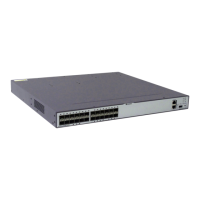Procedure
Step 1 Run:
system-view
The system view is displayed.
Step 2 Run:
bgp as-number
The BGP view is displayed.
Step 3 Run:
ipv6-family [ unicast ]
The BGP IPv6 unicast address family view is displayed.
Step 4 Run the following command to configure the outbound routing policy based on the following
different filters:
l Based on the routing policy
Run:
peer { ipv4-address | ipv6-address | group-name } route-policy route-policy-
name export
l Based on the ACL
Run:
peer { ipv4-address | ipv6-address | group-name } filter-policy { acl6-number |
acl6-name acl6-name } export
l Based on the AS_Path list
Run:
peer { ipv4-address | ipv6-address | group-name } as-path-filter { as-path-
filter-number | as-path-filter-name } export
l Based on the prefix list
Run:
peer { ipv4-address | ipv6-address | group-name } ipv6-prefix ip-prefix-name
export
The commands in Step 4 can be run regardless of the order.
The outbound routing updates policies used by the members of a peer group can be different
from that used by the group. That is, members of each peer group can select their policies
when advertising routes externally.
----End
8.5.7 Configuring the Policy for Receiving BGP4+ Routing
Information
Only the routes that match the policy for receiving routes can be received by BGP4+ peers and
added to the routing table.
Context
Do as follows on the BGP4+ switch:
S6700 Series Ethernet Switches
Configuration Guide - IP Routing 8 BGP4+ Configuration
Issue 01 (2012-03-15) Huawei Proprietary and Confidential
Copyright © Huawei Technologies Co., Ltd.
516

